Don’t you love it when people admire your clean, lush lawn that is the envy of your neighbors? Maintaining your lawn requires a lot of care and constant mowing. When you eventually see molehills around your compound, you know that disaster has arrived. Moles invade lawns digging endlessly, throwing out soil, and making a mess on your beautiful grass. They dig ferociously, leaving huge holes and damaging the foliage around your yard. What’s more, they eat all the valuable nutrients such as worms necessary for the soil nutrients. We’ve outlined great tips on how to identify the presence of moles in your home, and how you can spot potential danger zones, to avoid further damage.
[toc]
Common facts
- Are Moles Blind? Contrary to many people’s belief, moles are not blind; they have very tiny eyes that prevent them from clogging from the underground soil caused by their constant burrowing. They can see, but moles have very poor eyesight and cannot tell the difference between white and red. They can only detect daylight, darkness, and moving objects. However, moles have strong detectors around the small snout – a pink area covered in tiny pores that helps them in finding food and other animals hidden under the earth as they dig through the dirt.
Moles do not have strong smelling or hearing senses, but they are quite sensitive to touch. They sense vibrations in the earth and the surroundings. They have sensitive hairs and whiskers on their noses that help in detecting food in the soil.
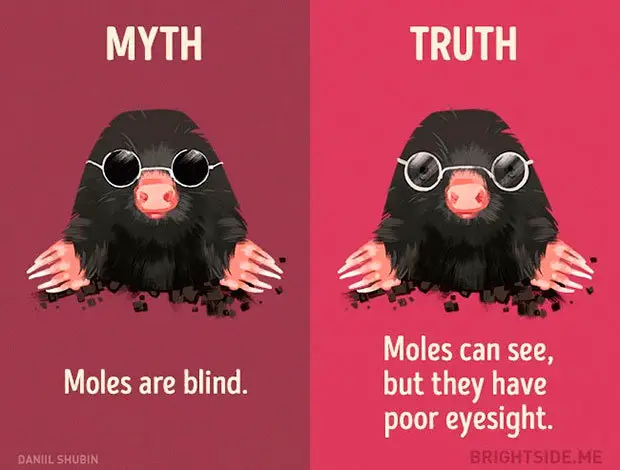
- How big do moles get? Moles measure about 15cm long. They do not grow into big creatures and usually weigh about 120g. Male moles are however slightly larger than their female counterparts. Moles have pinkish, plump, forearms with large front paws and pointed long claws strong enough to aid the animal with digging through soil and tunnel its way forward as it scavenges for food with muscular claws that enable the creature to burrow intensely in the earth. Their bodies generally take a cylindrical shape, devoid of a neck and a pointed pink nose. Moles are covered in dark, thick, fur.
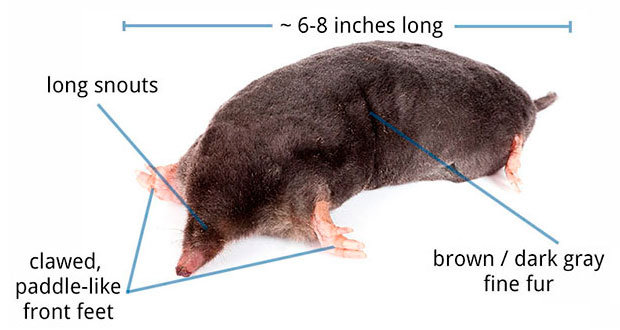
MOLE ANATOMY - Are they rodents? No. Moles are not rodents. They don’t feed on vegetation and plants or seeds. It’s, therefore, not easy to bait moles with food laced containing rodents poison. But you can discover how to get rid of moles naturally, should they invade your property and cause severe damage to your yard.
Moles belong to the Insectivores mammal group, and are somehow related to shrews. Some, occasionally found on open grounds include the Townsend’s or the broad-footed mole.
Food
Moles do not feed on plants and general vegetation in your garden. Moles are carnivores’ animals. They feed on worms and small rats and mice that accidentally pass through their tunnels. When you spot a mole in your yard, be careful not to touch it. Otherwise, it will bite it off and tear into your flesh. A mole’s saliva is toxic; this means it can paralyze earthworms, but not kill them.
Sometimes moles stock up collected worms in a secured burrow to feast on later. Moles do not eat dirt because it clogs up their internal systems. A mole will carefully remove soil and dirt from the dugout worms before ingesting or storing them to consume later.

Natural Habitat
- Moles spend considerable time in underground tunnels. They constantly dig to create hundreds of feet of intricate mazes which make it difficult to find a suitable method of how to kill moles. They prefer living in dry upper underground surfaces near old trees and dry temperate areas. They are commonly found in North America.
- Moles live in the underground in the seclusion of burrows and come to the surface rarely, or by accident. Finding two or three moles trapped in one area is rare. They hunt and dig separately, but you may find networks of tunnels joined but mostly worked on dug independently. Moles build their homes in dry spots but prefer to hunt in moist soil areas.
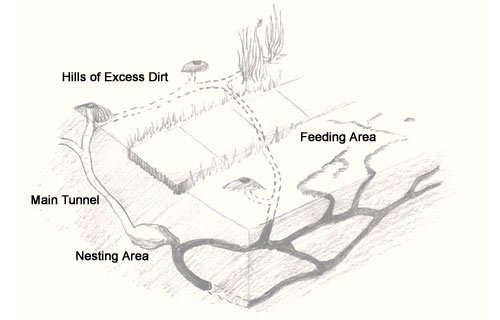
- Because of their demanding appetite for constant feeding, most must burrow through a large area when looking for worms to eat, or hoard to feed on later. The tunnels adjoin from the mole’s hunting grounds to its den. The dwelling area consists of unbalanced underground labyrinth hollows connected to deep tunnels measuring about 8 inches off the ground. The chambers from the passages measure about a quarter jar.
- During winter when the ground freezes, insects, and worms that dwell in the soil stay deeper in the earth where it’s warm and moist. Moles follow their prey, so they will naturally dig deeper, underground in search of food and safer burrows to stay in.
- During the quiet stillness of the night or early morning, moles find it the best time dig through their tunnels and feed. They mostly sleep in four-hour intervals during the day as well as at night. Their most operating hours are at dawn, and late in the evenings. Moles do not move about at night, so you can strategically place yard mole removal baits along their paths during the night to trap them at dawn when they come near the surface.

Mole Behavior
Activities: Known for their solitary lifestyles, the female mole may come out to the surface to breed her young ones. On most occasions, they prefer the underground territories where they dig and nest in alternating shifts.
Moles often come out of their hideouts at night to feed and search for new hunting territories.
Because of their secluded underground life and their strong, stench, moles do not make an easy meal for most mammals. However, a few animals like the coyotes and raccoons may dig them out to devour them.
Reproduction: Moles reach sexual adulthood at ten months and breed in their first winter. Depending on the species, mating occurs from winter to early summer. Moles reach adulthood, become sexually active at about ten months of age, and breed during their first winter.
- Moles prepare a burrow before mating by making deep tunnels to accommodate the couple for the mating session.
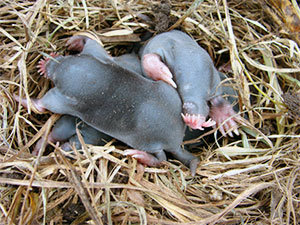 When a male mole finds his partner, also known as a sow, the two mates and the male mole immediately leave the sow to tend to her pregnancy, give birth, and look after her young ones.
When a male mole finds his partner, also known as a sow, the two mates and the male mole immediately leave the sow to tend to her pregnancy, give birth, and look after her young ones.- The gestation period is thirty days, and the moles produce a litter of 2-7 young ones.
- The males do not partake in raising the young ones. The young ones begin to move at about three weeks old, and by the time they are ten weeks old, the little moles leave their mother’s nest to go and fend for themselves.
- The highest life span of moles ranges four to six years.
Digging: How deep do moles dig?  Using forelimbs to dig, moles shear soil from the sides of the underground walls with quick strokes to create tunnels. They use the hind limbs to force their bodies forward against the tunnel walls. They then turn around and scoop the heaps of soil with their large forelimbs pushing it along the deep end leading closer to the surface.
Using forelimbs to dig, moles shear soil from the sides of the underground walls with quick strokes to create tunnels. They use the hind limbs to force their bodies forward against the tunnel walls. They then turn around and scoop the heaps of soil with their large forelimbs pushing it along the deep end leading closer to the surface.
The fore limbs dig deep, shoving soil to the sides of the earth tunnel with alternate strokes. The rear legs are used to support the mole’s body against the channel walls. The mole turns around, gathers up accumulated soil using its thick frontal limbs, and shoves it along the sides as it moves forward towards the surface.
During dry weather periods, moles dig deeper into the ground in search of moist areas where worms flock – under sidewalks, near sewer drain fields, rocky areas, and shaded hedges.
How do they dig deep tunnels? A mole’s typical terrain resembles a mazelike system of interlocked underground burrows.
- Moles construct dark tunnels and surface tunnels.
- Surface tunnels run approximately 4 inches deep into the ground. These appear as broad ridges 3-inch rips in the in the soil, or as mounds. In lawns, surface tunnels reveal the seams held collectively by the surrounding grass roots, – the peaks are visible and built without any particular plan.
- Moles revisit these burrows to feed, or to locate mates during the breeding season.
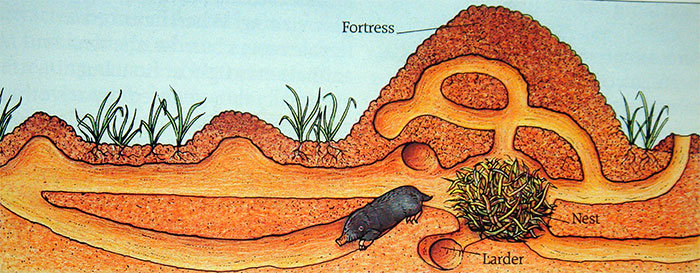
How fast can a mole dig? Moles are active diggers and can dig a tunnel at 15 feet per hour. In mild weather areas, they can build shallow tunnels at 12 inches per minute. Moles actively dig in the winter and fall season, when the soil is moist and soft to work through.
Signs of Moles in Your Yard
Due to the numerous dug out mounds and surface tunnels created, moles quickly pass as notorious pests in private property yards, golf courses, ball fields, horse fields, and other open luscious locations and along weak hedges. The creatures may also accidentally pull out small plants off the ground while tunneling. They cause damage to plants when the buildup mounds cover tiny seedlings. To prevent minor vegetation destruction, you may need to visit the dugout parts to uncover the seedlings as required.
Mole Invasion
Moles are difficult to exterminate since the channels created go miles, deep into the ground. They create multiple tunnels and can stay for weeks before revisiting a single surface area. If your property borders an area that is historically known as a haven for common mole digging, it’s nearly impossible to eradicate the little busy creatures. You may successfully remove some of them using baits.
Holes in your Farm or Grazing land
While you remove an existing mole invasion area or drive them away from your property, if the soil around your yard favors their existence, other moles will ultimately move into the already existing tunnels. Moles damage surface foliage, sometimes depriving domesticated animals a place to graze, or worst still, damage agricultural machinery that gets stuck in the holes created during their excavation exercise.

Why Do They Make Molehills?
Molehills crop up in moist, free earth created on lawns, in golf, or pasture fields, and along wood edges, and other grasslands where moles can easily find earthworms and insects to feed on. When tunneling, the underground animal excavates materials and loose soil, piling it up in mounds measuring approximately 10-20 inches wide and 2-10 inches high above the ground. The opening burrow is often next to the molehill, plugged in neatly but lacks any significance.
The creatures produce these mounds when looking for food as they muscle forward in swimming style, pushing the soil aside to build tunnels. While on the last stretch of digging, moles toss out the ground, towards the surface forming molehills or mounds. They rarely come out of the ground and will turn around and continue tunneling endlessly in search of food.
You can kill moles in your yard by the use of baits which attract them as they try to remove the baits out of the way. A favorite effective bait comes in the shape of a worm. It’s laced with an attractive smell combined with a toxic ingredient – Bromethalin used for killing moles.
The best trap works when you place it near the molehill hounds on flat ground where they haven’t dug. You can also use s scissor trap for dark mole runs as a trap.
Another trick to use is a harpoon trap, which works best if the tunnels are almost above the ground. Mole traps and baits are available at many hardware or farm supply stores.




IM HAVING A MOLE ISSUSE AND DONT KNOW ALOT OTHER THAN THERE ANNOYING AND LOVE ROOTS
ONLY JUICY FRUIT GUM? AND HAS TO BE STICKS?
Juicy fruit gum. Half a stick in a open tunnel will clog them up and kill them.
This year I have shot 35 moles with a 38. I have slowed them down but in no way have I got rid of them all. I shot one every 2 days.
Wish you lived near here as I trap them and very successful at it.last year I got 59 and this year 65 I have about fifteen clients and it is fun to trap moles for them
How do you trap them? I’m not very successful 🙁
I have so many moles in my flower beds and front and back lawn and I have problems locating all the tunnels I can’t even put my flowers in until I get rid of them
harpoon them